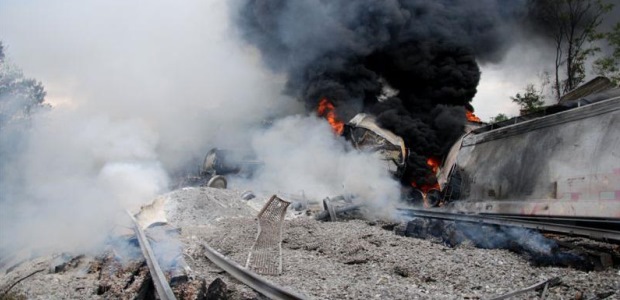
NTSB: Prohibit Hands-Free Phone Use by Commercial Drivers
The safety board determined Oct. 22 that a truck driver involved in a collision with a train in May 2013 was distracted because of a phone conversation he was having at the time.
The National Transportation Safety Board issued its report Oct. 22 on the probable cause of a May 28, 2013, truck/train collision at a private grade crossing located in Rosedale, Md. The collision involved a CSX Transportation Co. freight train and a truck driven by the owner of Alban Waste LLC on a private road leading to a recycling center. Fifteen rail cars derailed, including three that contained hazardous materials that leaked, resulting in an explosion and a fire. The truck driver was seriously injured but survived, and he admitted to investigators that he was talking on a hands-free cell phone at the time of the collision.
The report says the train sounded its horn three times as it approached the crossing, and that the driver commenced a call one second before the first horn sounded. The driver told investigators he did not hear a horn until the impact was imminent.
"Contributing to the crash were (1) the truck driver's distraction due to a hands-free cell phone conversation; (2) the limited sight distance due to vegetation and roadway curvature; and (3) the Federal Motor Carrier Safety Administration's inadequate oversight of Alban Waste, LLC, which allowed the new entrant motor carrier to continue operations despite a serious and consistent pattern of safety deficiencies. Contributing to the severity of the damage was the postcrash fire and the resulting explosion of a rail car carrying sodium chlorate, an oxidizer," the report states.
It describes the truck driver as a 50-year-old male who had been a fire truck driver for the Baltimore County Fire Department before retiring in 2008. He then drove for container delivery businesses before opening his company in 2011.
The board concluded he had severe, untreated obstructive sleep apnea that probably affected his alertness, but he did not disclose this diagnosis on the DOT fitness exam forms and continued to operate as a commercial vehicle driver, and his personal physician medically certified him despite being aware of his severe OSA.
This is not the first investigation in which NTSB has issued recommendations regarding hands-free phones. This report states, "The NTSB continues to maintain that distraction from the use of hands-free PEDs [portable electronic devices] while driving poses an unnecessary safety risk. Current laws that ban hand-held but not hands-free PED use can foster an environment in which drivers erroneously believe that the use of hands-free PEDs is as safe as not using PEDs at all. The circumstances of the Rosedale highway–railroad grade crossing collision demonstrate that distractions from hands-free conversations can lead to catastrophic results. Therefore, the NTSB recommends that the FMCSA modify 49 CFR 392.82 to prohibit any use of a hands-free PED by a CDL holder while the driver is operating a commercial vehicle, except in emergencies."
The report says the driver said he typically did not stop before entering this crossing unless he heard a train's horn. Surveillance video from a nearby business showed him and others driving through the crossing several times that day and during three days prior without coming to a stop, it states.